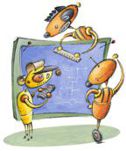DATE: Thursday, March 22, 2007
TIME: 12:00 pm - 1:00 pm
PLACE: CIC 2101
SPEAKER:
Rahul Mangharam
CMU
TITLE:
Cross-Layer Design for Real-Time Embedded Wireless Networks
ABSTRACT:
There is an increasing need for real-time wireless communications in medical care, surveillance and vehicle-to-vehicle networks. Currently, such embedded wireless networks suffer from short battery life, unpredictable real-time performance and poor scalability. To enable multi-hop wireless network applications with predictable and well-defined real-time properties, I present a cross-layer approach to design networked wireless systems. My research is applied across three segments spanning broadband wireless transceivers (MEERA), low-cost wireless sensor networks (FireFly) and highly mobile vehicular networks (GrooveNet).
MEERA is a Methodology for Energy-Efficient Resource Allocation for broadband wireless transceivers. MEERA determines, at run-time, the optimal settings across RF electronics, communication tradeoffs and the link layer to deliver delay-sensitive data streams over a time-varying channel. MEERA increases the system lifetime by a factor of 3-to-8.
FireFly is a dual-radio sensor networking platform with predictable and near-optimal node lifetimes (up to 2 years on two AA batteries). We achieve this through tight hardware-based global time-synchronization with sub-100us synchronization accuracy. A 42-node network was deployed in a Coal Mine for miner rescue and multi-hop voice streaming.
Vehicular wireless networks will make driving safer, more efficient and more enjoyable. I have built GrooveNet, a vehicular network virtualization platform where the same network models are used both in simulation and in real mobile test-beds, while allowing interaction between real and virtual vehicles. By accurately modeling inter-vehicular communication among thousands of vehicles within a street map-based topography, GrooveNet facilitates protocol analysis, rapid in-vehicle deployment and model validation. GrooveNet is open-source and is being used by over 18 research institutions for protocol design in vehicular networks.
BIO:
Rahul Mangharam is a Ph.D. candidate in Electrical & Computer Engineering at Carnegie Mellon University, USA. His interests are in scheduling algorithms for wireless and embedded systems. In 2002, he was a member of technical staff in the Ultra-Wide Band Wireless Group at Intel Labs. Rahul was an international scholar in the Wireless Systems Group at IMEC, Belgium in 2003. He was a visiting researcher at Athens Institute of Technology, Greece in the summer of 2006. Rahul has worked on ASIC chip design at Marconi Communications (1999) and Gigabit Ethernet at Apple Computer Inc. (2000). When he is not busy building systems, Rahul revels off the beaten path & hikes mountains in the great outdoors. Rahul can be reached at rahul@cmu.edu.
SDI / LCS Seminar Questions?
Karen Lindenfelser, 86716, or visit www.pdl.cmu.edu/SDI/
